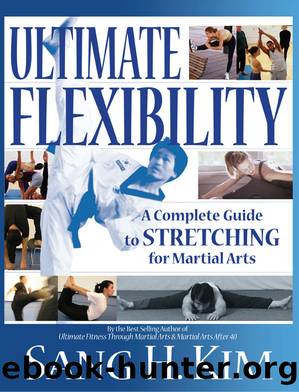Ultimate Flexibility: A Complete Guide to Stretching for Martial Arts by Kim Sang H

Author:Kim, Sang H. [Kim, Sang H.]
Language: eng
Format: epub
Publisher: Turtle Press
Published: 2004-01-09T16:00:00+00:00
Chapter 6: The Exercises
There are no secrets or shortcuts to maximum flexibility, but there are some easy things you can do to get the most out of every stretching session.
Quick Tips
There are no secrets or shortcuts to maximum flexibility, but there are some easy things you can do to get the most out of every stretching session:
⢠Choose exercises that target the muscles you use in your martial arts movements or with a specific goal in mind. Avoid stretching for the sake of stretching.
⢠Stretch both sides of the body equally. Many stretches provide directions for one sideârepeat the stretch on the other side as well.
⢠Always warm-up before stretching.
⢠Stretch daily or at every workout.
⢠Stretch opposing muscles equally.
⢠Focus on the muscle(s) being stretched while minimizing movement in the rest of the body.
⢠When possible, isolate a single muscle group to improve the feedback you receive while stretching.
⢠Hold each stretch for 15-20 seconds. Holding a stretch beyond 30 seconds does not result in increased gains.
⢠Inhale prior to a stretch and exhale as you move into the stretch. Breathe evenly and comfortably while holding a stretch.
⢠Stretch the same muscle in a variety of positions and at a variety of angles.
⢠Prior to a stretch, focus on relaxing the target muscle.
⢠Stop if you experience:
o joint pain
o sharp or sudden muscular pain
o dizziness, light-headedness or shortness of breath
⢠Move into static stretches gradually, maintaining awareness of the muscle group and the amount of tension you are placing on it.
⢠It is unnecessary to stretch to the point of extreme pain. Once you feel tension, the muscle is being stretched (elongated beyond its current limit). Beyond this point, added tension may inhibit rather than enhance the stretch.
⢠On competition days, stretch as close to your event as possible to take advantage of the immediate benefits of stretching.
⢠Know where you should feel tension in each stretch. If you are performing a hamstring stretch and feeling tension in your low back, calf or knee, something is wrong with your positioning.
Safety
There are a number of cautions that should be observed when stretching, no matter how experienced or fit you are.
⢠The most important rule is to use common sense and listen to your body. Taking an aggressive approach to stretching can do more harm than good. You canât make up for a week of missed practices in one day. Attaining maximum flexibility requires patience. Take a long-term approach and work with your body, not against it.
⢠If you are uncertain about your readiness for any of the exercises presented here, consult with your physician, trainer, coach or instructor.
⢠A mild sensation of burning or pulling should be felt in the target muscles when stretching. It should be mildly uncomfortable but never unbearable.
⢠Wear appropriate clothingâloose fitting workout clothes or your martial arts uniform.
⢠Practice on a non-skid surface. Many standing stretches require a solid base.
⢠Stretching barefoot is recommended. If this isnât possible, a pair of flexible martial arts shoes is the next best thing.
Download
This site does not store any files on its server. We only index and link to content provided by other sites. Please contact the content providers to delete copyright contents if any and email us, we'll remove relevant links or contents immediately.
Bodyweight Strength Training by Jay Cardiello(7180)
Tools of Titans by Timothy Ferriss(6934)
Born to Run: by Christopher McDougall(6249)
Inner Engineering: A Yogi's Guide to Joy by Sadhguru(5886)
Asking the Right Questions: A Guide to Critical Thinking by M. Neil Browne & Stuart M. Keeley(4564)
The Fat Loss Plan by Joe Wicks(4231)
Bodyweight Strength Training Anatomy by Bret Contreras(4053)
Yoga Anatomy by Kaminoff Leslie(3696)
Science and Development of Muscle Hypertrophy by Brad Schoenfeld(3573)
Dynamic Alignment Through Imagery by Eric Franklin(3481)
The Four-Pack Revolution by Chael Sonnen & Ryan Parsons(3480)
ACSM's Complete Guide to Fitness & Health by ACSM(3459)
Yoga Anatomy by Leslie Kaminoff & Amy Matthews(3392)
Bodyweight Strength Training: 12 Weeks to Build Muscle and Burn Fat by Jay Cardiello(3347)
The Ultimate Bodybuilding Cookbook by Kendall Lou Schmidt(3308)
Exercise Technique Manual for Resistance Training by National Strength & Conditioning Association(3285)
Nutrition for Sport, Exercise, and Health by Spano Marie & Kruskall Laura & Thomas D. Travis(3232)
Nutrition for Sport, Exercise, and Health by Marie Spano & Laura Kruskall & D. Travis Thomas(3228)
Yoga Therapy by Mark Stephens(3217)
